Roofs and Ceilings
Free phone us for building surveys
We are highly qualified Independent Surveyors with many years of experience of dealing with all types of property and it's related problems. We offer Building Surveys also known as Structural Surveys, Commercial Surveys, Engineers Reports, Independent Valuations and Specific Defect Reports on things such as roof problems, cracking and dampness.
Please free phone us on 0800 298 5424 for a friendly chat.
Old plaster ceilings
The older plaster ceilings that we commonly come across are in Tudor buildings, Georgian buildings, Regency buildings and Victorian and Edwardian buildings. All of these buildings have used a lime plaster and they have used it on timber laths. This is a completely different construction to modern gypsum plasterboard and has completely different properties. Unfortunately, most people and most builders don't understand the difference as they look very similar.
The properties of lath and plaster
One of the great things about an old lime lath and plaster ceiling is that it has to breathe properly to be able to move and absorb moisture. It is far more resilient than a modern gypsum plasterboard ceiling, which is not surprising when you think about the amount of work that was put in to putting a lath and plaster ceiling in place. Each of the timber laths had to be first of all laid, which in itself is a job and a half. These in our experience tend to be an inch wide or 2.5cm or 25mm, whichever way you wish to look at it, and run for several feet or metres, again depending how you think. These are all fixed to the ceiling joists. Then a two or three coat layer of lime plaster is added. This lime plaster will often have a horse or ox hair mix as a bonding agent. All of this will then give a ceiling finish that is slightly undulated and has texture and certainly isn't as smooth as a modern ceiling but we feel has a lot of character and is well worth preserving.

Showing a damaged lath and plaster ceiling where you can see the timber laths and the plaster coming away and it is held together by horsehair
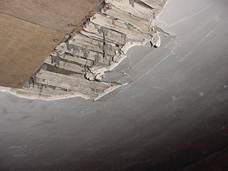
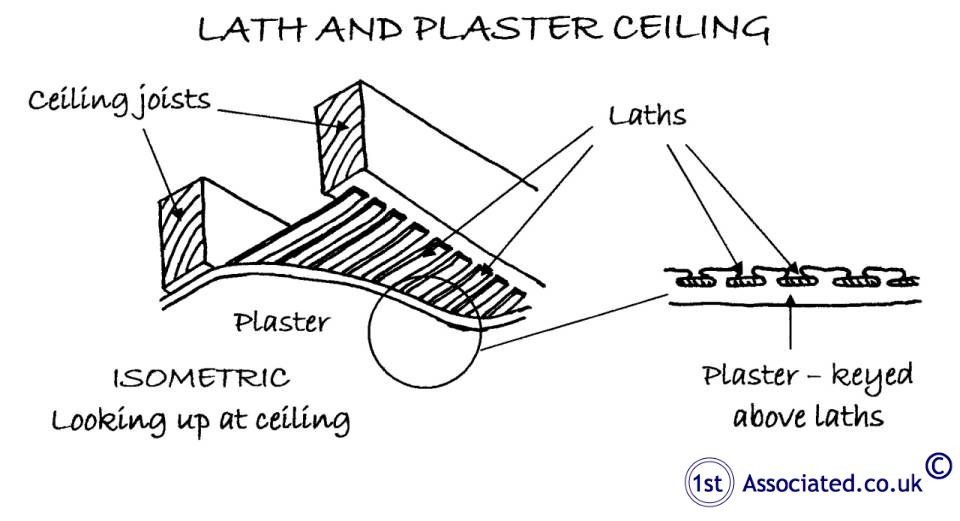
Lath and plaster ceiling
How do you identify if it's a lath and plaster ceiling?
Quite simple, you go in the roof space and have a look at the ceiling.
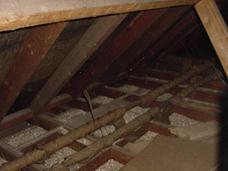
This is a photo looking at a
plasterboard ceiling

This is a photo looking at a lath and
plaster ceiling
How can you tell the difference?
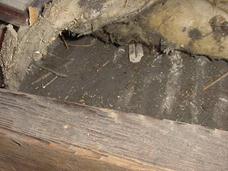
If you have a very close look you can
just about see the lath and the lime plaster
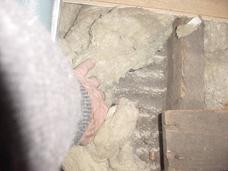
Having an even closer look
Things that you often see in lath and plaster ceilings
Things like decorative roses and decorative architraves.

Decorative roses around the lights
and decorative architraves
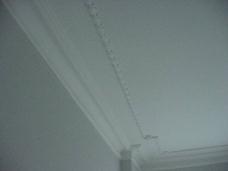
Decorative architrave

Decorative architrave
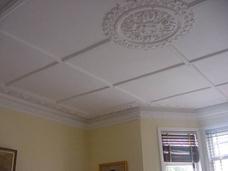
Decorative ceiling rose
However, be aware of imitations that are formed out of polystyrene.
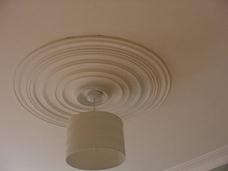
Imitation ceiling rose
A bit more about decorative architraves
We are forever seeing these where the detail has been lost as they have been painted. A far better way to treat a lime plaster ceiling is to lime wash the decorative architrave. This way you will still be able to see the detail.
I've got cracks in my ceiling is it going to fall down?
The answer is we don't know unless we come and look at it. Lath and plaster ceilings are able to withhold and cope with lots of movement in a property which is good news, but equally they can hide a structural problem as they don't fail in the same way (fall down) as a modern gypsum plaster ceiling.
How do I find out if the cracks in my ceiling are structural cracks or not?
The easiest way is to phone us and have a discussion. We may or may not have to come out depending upon what we find when we are chatting to you. If you do wish to ring us up on 0800 298 5424 please make sure you have some details of your property to hand, such as how it's constructed, the age of the property and any alterations or amendments that have been carried out.
Repairing older ceilings
Older ceilings sometimes crack and fail due to a variety of reasons. The best way to repair them providing the plaster has not lost its key with the lath is to use a flat ‘U' shaped cut into the joint area and apply plaster of Paris and then cross line the cracked area with lining paper and decorate the entire ceiling.
Modern gypsum plasterboard ceiling cracks
These ceiling cracks tend to be straight, although you do have to know what you are looking for, as equally a straight crack could indicate there is movement elsewhere within the property, perhaps due to a wall being removed or perhaps due to an extension being added to a house. There are so many factors that have to be considered when trying to establish if it's a structural crack and then furthermore trying to establish if it's a structural crack with progressive movement, which is what the mortgage companies fear and don't wish to lend you money on and what insurance companies don't wish to insure on and is certainly worth avoiding.
You may be interested in the following articles:
More about us and Caveat Emptor, why have a Building Survey?
Caveat Emptor means Buyer Beware and is why we always recommend you have a building survey carried out on the property.
As part of our structural surveys we often find cracking in properties. The surveyor needs to establish whether they are long standing or progressive and then look for the reasons behind them.
A building survey prepared by a building surveyor could literally save you thousands of pounds. The survey only needs to uncover one potential problem and the cost of the building survey is more than recovered.
Compare the quality of our Building Surveys but don't compare Apples with Thursdays!
If you require a Building Survey or a Structural Survey on a home, house or commercial property we as Building Surveyors have a wealth of experience and expertise that we can utilise to help you.
We are more than happy to email you example surveys. We have surveyed many different types and eras of property from modernised Georgian properties to large industrial buildings.
We really believe that you should see what you are getting in the form of an example Survey. What is more is that we are so confident with our higher than average standards that we believe that there is no other comparable survey available in the UK property and surveying market.
Our unique sketches help you understand the survey and our ovals and circles on our photos and sketches highlight specific areas
If the report, along with our photos, does not explain the problem or characteristics of a property enough then we also have a vast range of sketches like the one shown here that we have had commissioned exclusively for us that we can use in our reports.
The circles and ovals we use with our photos and sketches are to highlight a specific area.

An example of one of our sketches
Commercial Property
If you have a commercial property, whether it is freehold or leasehold then sooner or later you may get involved with dilapidation claims. You may wish to look at our Dilapidations Website at www.DilapsHelp.com and for Disputes go to our Disputes Help site www.DisputesHelp.com .
Our articles
We hope you found the article of use and if you have any experiences that you feel should be added to this article that would benefit others, or you feel that some of the information that we have put is wrong then please do not hesitate to contact us (we are only human).
The contents of the website are for general information only and are not intended to be relied upon for specific or general decisions. Appropriate independent professional advice should be paid for before making such a decision.
1stAssociated rights
All rights are reserved the contents of the website are not to be reproduced or transmitted in any form in whole or part without the express written permission of www.1stAssociated.co.uk .
